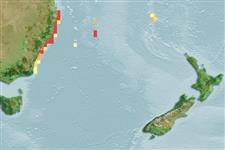Teleostei (teleosts) >
Perciformes/Serranoidei (Groupers) >
Anthiadidae (Fairy basslets or Streamer basses)
Etymology: Caprodon: Latin, capra = goat + Greek, odous = teeth (Ref. 45335); krasyukovae: Named in honor of Z.V. Krasyukova, one of the authors of Fishes of the Sea of Japan and adjoining parts of the Yellow Sea (1969) (Ref. 43805).
Eponymy: Dr Zoya Valentinovna Krasyukova (ca: 1928–1991) was a Soviet ichthyologist at the Laboratory of Ichthyology, part of the Zoological Institute of Russian Academy of Sciences having been an assistant at Leningrad University. [...] (Ref. 128868), visit book page.
Environment: milieu / climate zone / depth range / distribution range
Ecology
Marine; demersal; depth range ? - 55 m (Ref. 120532). Temperate
Western Pacific, Lord Howe Island region to southern Queensland and New South Wales.
Size / Weight / Age
Maturity: Lm ? range ? - ? cm
Max length : 47.0 cm SL male/unsexed; (Ref. 43805)
Short description
Identification keys | Morphology | Morphometrics
Found on the continental shelf. Benthic (Ref. 75154).
Life cycle and mating behavior
Maturity | Reproduction | Spawning | Eggs | Fecundity | Larvae
Kharin, V.Y. and V.A. Dudarev, 1983. A new species of the genus Caprodon Temminck et Schlegel, 1843 (Serranidae) and some remarks on the composition of the genus. J. Ichthyol. 23(1):20-25. (Ref. 43805)
IUCN Red List Status (Ref. 130435: Version 2024-1)
Threat to humans
Harmless
Human uses
Tools
Special reports
Download XML
Internet sources
Estimates based on models
Preferred temperature (Ref.
123201): 20.2 - 23.3, mean 22.3 °C (based on 10 cells).
Phylogenetic diversity index (Ref.
82804): PD
50 = 0.6250 [Uniqueness, from 0.5 = low to 2.0 = high].
Bayesian length-weight: a=0.01349 (0.00618 - 0.02945), b=3.00 (2.81 - 3.19), in cm total length, based on LWR estimates for this (Sub)family-body shape (Ref.
93245).
Trophic level (Ref.
69278): 3.7 ±0.5 se; based on size and trophs of closest relatives
Resilience (Ref.
120179): Low, minimum population doubling time 4.5 - 14 years (Preliminary K or Fecundity.).
Fishing Vulnerability (Ref.
59153): Moderate vulnerability (43 of 100).
